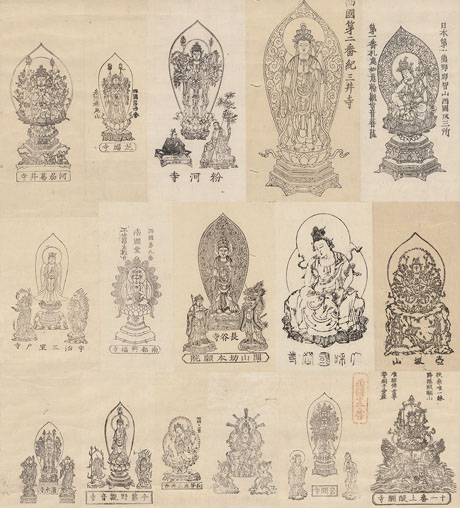Preludes to an Exhibition
In the exhibition “Tokens of the Path – Japanese Devotional and Pilgrimage Images: The Wilfried Spinner Collection (1854–1918),” (November 28, 2014 until May 17, 2015), the University of Zurich’s Ethnographic Museum presents Japanese religious paintings and prints that were collected by the Swiss theologian and pastor Wilfried Spinner, who worked as a missionary in Japan from 1885 to 1891. This collection is accessible to the public for the first time. In what follows, the curator of the Asia collections Martina Wernsdörfer provides insight into the story behind the exhibition.
Martina Wernsdörfer

The Ethnographic Museum’s exhibit “Tokens of the Path” has a lengthy backstory related to Wilfried Spinner’s family connections to Zurich; a growing interest in Japanese-Buddhist objects in European museums; and the liberal currents in 19th century Christian theology.
Born in 1854 in Bonstetten near Zurich, Wilfried Spinner studied theology at the University of Zurich and came into contact with liberal theological circles and, specifically, the pastor Ernst Buss. These groups pursued a version of Christianity free of dogma and open toward other religions, though not to the exclusion of missionary work. Having co-founded the General Evangelical-Protestant Missionary Society in Weimar in 1884 with Buss and others, Spinner traveled to Japan in 1885 as the first missionary commissioned by the organization. He was simultaneously a pastor with duties abroad, operating in service of the Grand Duke of Saxony-Weimar-Eisenach and working with German-speaking congregations in Tokyo and Yokohama.
In Japan, he made use of local contacts in order to gain familiarity with religious ideas, deities, and customs. Over the years, he acquired some one hundred cultic and pilgrimage images—paintings and printed amulets (Jap. ofuda)—that he used for religious-historical studies. He had the contents explained and left behind written notes on some images. The notes consist mainly of transliterated Japanese terms, accompanied at times by brief explanations in German. In April of 1891, Spinner returned to Europe with his collection. From Switzerland he soon moved to Germany and was eventually promoted to the level of General Superintendent of the Saxony Grand Ducal church council. He died in Weimar in 1918.
Religious actions and forms of belief
Because of Spinner’s family ties to Zurich, his collection finally found the way to the Ethnographic Museum. While in Switzerland he was married to Bertha Stoll, whose brother was Otto Stoll, a professor of geography and ethnography at the University of Zurich. From 1889 to 1898, he was also the director of the ethnographic collection (today, the Ethnographic Museum). Otto’s youngest daughter Eva Stoll worked from 1962 to 1975 as the museum’s Asia curator and, after retiring, she established contact between Spinner’s relatives and the Ethnographic Museum, which in 1985 received eighty image-scrolls from Spinner’s collection. This donation of the images turned what were formerly objects of personal study into objects of academic research in a museum environment.
When Hosei University and the University of Zurich’s Japanology department in 2010 asked the Ethnographic Museum to join them in an international research project on Japanese-Buddhist objects in European collections, it was a chance to engage the image-scrolls anew. With the support of numerous specialists from Japan, it has been possible over the past three years to understand central elements of “the Wilfried Spinner collection,” as well as aspects of its historical context. The eighty image-scrolls proved to be key in approaching a variety of religious actions and forms of belief. They offer a strongly panoramic profile of Japan’s religious landscape in the Edo period and Meiji era. A fitting occasion to display the images arose in 2014 with the 150th anniversary of diplomatic relations between Japan and Switzerland, an event that provided an opportunity to present in both the exhibition and in publication the research results of Tomoe Irene Maria Steineck and Martina Wernsdörfer, respectively, the guest curator and the curator of the Ethnographic Museum’s Asia collections.
(Asia & Europe Bulletin, 4/2015, pp. 21–22)